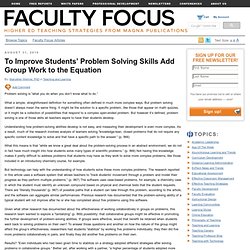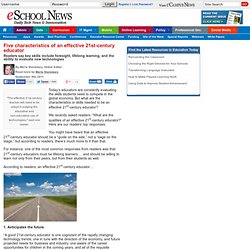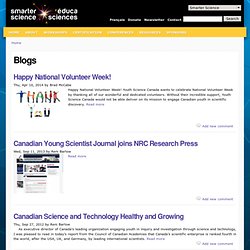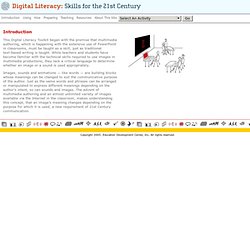

To Improve Students’ Problem Solving Skills Add Group Work to the Equation. August 31, 2010 By: Maryellen Weimer, PhD in Teaching and Learning Problem solving is “what you do when you don’t know what to do.”

What a simple, straightforward definition for something often defined in much more complex ways. But problem solving doesn’t always mean the same thing. It might be the solution to a specific problem, like those that appear on math quizzes, or it might be a collection of possibilities that respond to a complex open-ended problem.
Understanding how problem-solving abilities develop is not easy, and measuring their development is even more complex. What this means is that “while we know a great deal about the problem-solving process in an abstract environment, we do not in fact have much insight into how students solve many types of scientific problems.” But technology can help with the understanding of how students solve these more complex problems. Results? But that wasn’t all. Conclusion? Reference: Cooper, M. Recent Trackbacks - Maths with Adil [...] The Collaborative Classroom. M.B.

Tinzmann, B.F. Jones, T.F. Fennimore, J. Bakker, C. Fine, and J. New Learning and Thinking Curricula Require Collaboration In Guidebook 1, we explored a "new" vision of learning and suggested four characteristics of successful learners: They are knowledgeable, self-determined strategic, and empathetic thinkers. Effective communication and collaboration are essential to becoming a successful learner. This focus on the collective knowledge and thinking of the group changes the roles of students and teachers and the way they interact in the classroom. The purpose of this GuideBook is to elaborate what classroom collaboration means so that this grass-roots movement can continue to grow and flourish.
Characteristics of a Collaborative Classroom Collaborative classrooms seem to have four general characteristics. 1. In traditional classrooms, the dominant metaphor for teaching is the teacher as information giver; knowledge flows only one way from teacher to student. 2. eSchool News » Five characteristics of an effective 21st-century educator » Print. Readers say key skills include foresight, lifelong learning, and the ability to evaluate new technologies By Meris Stansbury, Online Editor Read more by Meris Stansbury September 9th, 2011 "The effective 21st-century teacher will need to be adept in judging the educative and non-educative use of technologies," said one reader.

Today’s educators are constantly evaluating the skills students need to compete in the global economy. But what are the characteristics or skills needed to be an effective 21st-century educator? We recently asked readers: “What are the qualities of an effective 21st-century educator?” You might have heard that an effective 21st-century educator should be a “guide on the side,” not a “sage on the stage,” but according to readers, there’s much more to it than that. The Evolution of a 21st Century Educator. Happy National Volunteer Week!

Youth Science Canada wants to celebrate National Volunteer Week by thanking all of our wonderful and dedicated volunteers. Without their incredible support, Youth Science Canada would not be able deliver on its mission to engage Canadian youth in scientific discovery. Read more As executive director of Canada's leading organization engaging youth in inquiry and investigation through science and technology, I was pleased to read in today's report from the Council of Canadian Academies that Canada's scientific enterprise is ranked fourth in the world, after the USA, UK, and Germany, by leading international scientists.
Read more Chris Hadfield to Perform Winning Experiment in Space. Deadline: Extended to May 4th, 2012 Read more Science in School is a European journal to promote inspiring science teaching. Hi, I'm Martin Adebayo, a Grade 11 student at a High School in Southern Ontario. Inquiry-based science instruction—what is it and does it matter? Pages. 21st Century Educator. Digital Literacy: Skills for the 21st Century: Introduction. This Digital Literacy Toolkit began with the premise that multimedia authoring, which is happening with the extensive use of PowerPoint in classrooms, must be taught as a skill, just as traditional text-based writing is taught.

While teachers and students have become familiar with the technical skills required to use images in multimedia productions, they lack a critical language to determine whether an image or a sound is used appropriately. Images, sounds and animations — like words — are building blocks whose meanings can be changed to suit the communicative purpose of the author. Just as the same words and phrases can be arranged or manipulated to express different meanings depending on the author’s intent, so can sounds and images. Www.jitt.org.